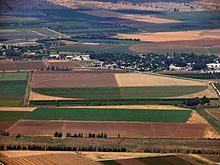
Biodiversity in agriculture is the measure of biodiversity found on agricultural land. Biodiversity is the total diversity of species present in an area at all levels of biological organization.[1] It is characterized by heterogeneous habitats that support the diverse ecological structure.[1] In agricultural areas, biodiversity decreases as varying landscapes are lost and native plants are replaced with cultivated crops.[1] Increasing biodiversity in agriculture can increase the sustainability of farms through the restoration of ecosystem services that aid in regulating agricultural lands.[2] Biodiversity in agriculture can be increased through the process of agroecological restoration, as farm biodiversity is an aspect of agroecology.
Biodiversity is the measure of biotic and abiotic diversity in an ecosystem, described by heterogeneity.[1] The loss of biodiversity in agriculture has been an increasing issue since the global increase of food demands and success of popular crops.[3][4] This loss of heterogeneity declines species biodiversity on agricultural lands.[5] Biodiversity in agriculture is essential in providing ecosystem services, which conserves biodiversity while providing agricultural services.[6]
- ^ a b c d Harlan JR, Gepts P, Famula TR, Bettinger RL, Brush SB, Damania AB, McGuire PE, Qualset CO (2012-02-23). Biodiversity in Agriculture: Domestication, Evolution, and Sustainability. Cambridge University Press. p. 5. ISBN 978-0-521-76459-9.
- ^ Duru M, Therond O, Martin G, Martin-Clouaire R, Magne M, Justes E, et al. (October 2015). "How to implement biodiversity-based agriculture to enhance ecosystem services: a review". Agronomy for Sustainable Development. 35 (4): 1259–1281. doi:10.1007/s13593-015-0306-1. ISSN 1773-0155. S2CID 256204561.
- ^ Cite error: The named reference
Benton_2003was invoked but never defined (see the help page). - ^ Cite error: The named reference
Khoury_2014was invoked but never defined (see the help page). - ^ Cite error: The named reference
Martin_2020was invoked but never defined (see the help page). - ^ Cite error: The named reference
Robertson_2014was invoked but never defined (see the help page).